|
February
19
The Southern Cross was still out
when we got up at five, and Venus hung low in the eastern sky. The
air was cooler in the morning here in the desert, and crystal
clear, with not a cloud in sight. We drove into a red dawn. The
sunrise sky was a gradient from fiery orange at the horizon, to
magenta, mauve and finally fading to a dusky blue.
We came upon a lone
female ostrich, side lit by the early morning light. She turned
and ran straight toward the sun, zig-zagging comically from side
to side, dipping and bobbing. A bit further on we caught up with
her when she stopped to preen her feathers.
A small brown bird
perched on a thornbush and sang out a single note, repeating it
over and over, unvarying. Gee
told us it was a Monotonous Lark, named for its one-note song.
Kind of a mean name, I thought.
|
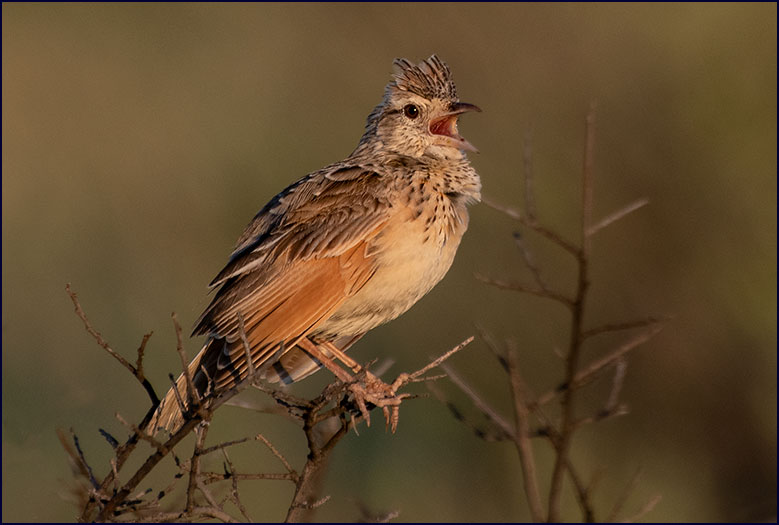
Monotonous Lark |
We came out to the open
grassy plain, and a whole herd of springboks were grazing there,
hundreds of them, right near the road. The adults mostly just grazed, but several
of the young males were butting their heads together.
We watched as they went
about their business, close enough to see the golden morning light
gleaming in their eyes.
Then some of the younger
springboks started to play, running back and forth in the cool
morning breeze for the sheer joy of it. Several of them began
leaping in the air in a series of very high, straight-legged
bucks, with their backs rounded and their heads down. Gee said
this is called pronking.
It was very comical to watch; their leaps would have done a
bucking bronco proud.
|
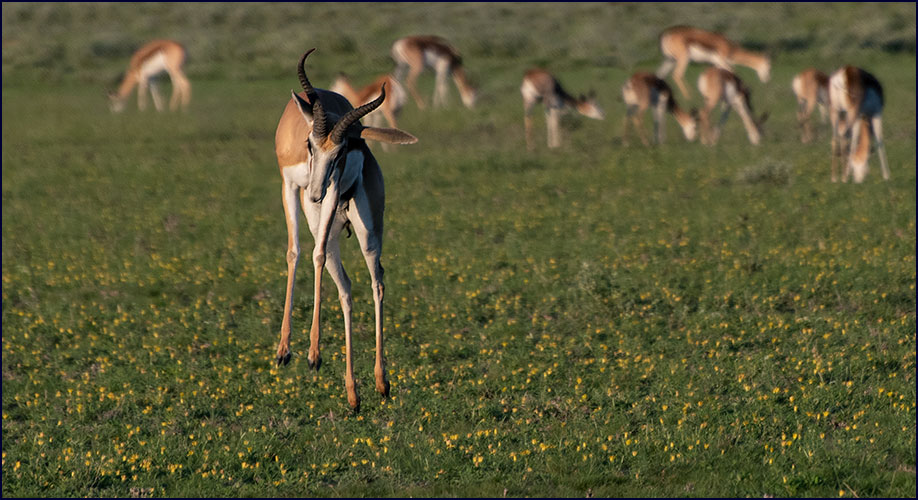
Pronking
|
The road led us past a
lovely copse of trees where there was a little sign that said No Camping. Gee told us that this was the spot where Mark and Delia
Owens had set up their camp, as described in their book The Cry of the Kalahari. Having been captivated by reading their
books and intrigued by their lifestyle while living in the
Kalahari conducting wildlife research, I thought it was really
cool to see their campsite.
|
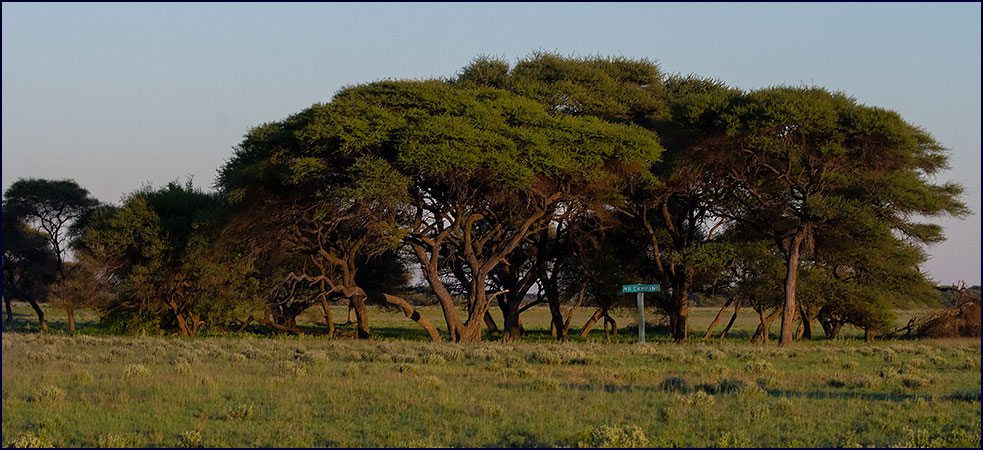
Mark and Delia Owens' campsite
|
A trio of gemsboks grazed
by the road, and we got our first really good close look at them.
These antelopes are large and strong; they look a little like a
cross between a small horse and a Brahma bull. From the shoulder
back they look rather horse-like, with rounded rumps and a black
bushy tail. Their necks and heads appear more bovine.
They are a pale greyish brown color with white stomachs, a
slanted black stripe on their sides, and vivid black and white
markings on their legs and head. Males and females both have
immensely long straight spiraled horns.
|
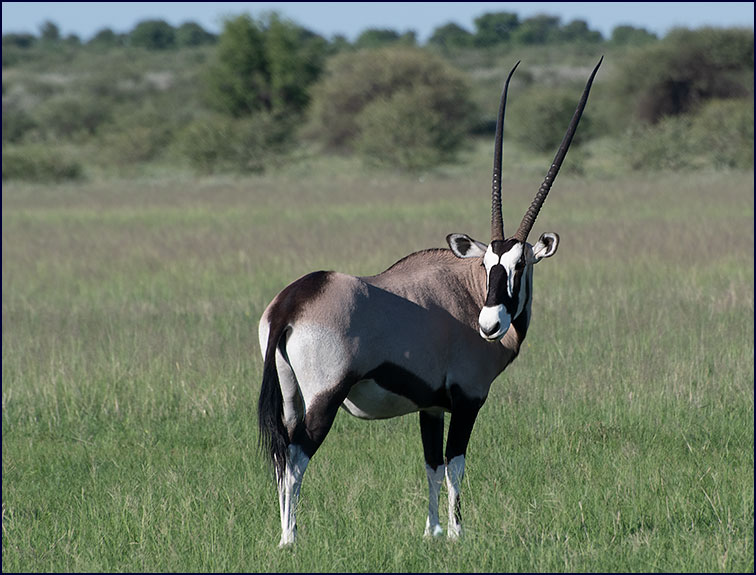
Gemsbok
|
Gee told us that lions
have to know how to hunt the gemsboks, or they would be killed.
The oryx kneel down and put their heads between their front legs
with the horns pointing forward, and use them to spear their foes.
Lions from outside the Kalahari would be killed if they try
to hunt gemsboks the same way they hunt other antelopes.
The
morning was rich with bird song. We identified a Chat Flycatcher,
as well as three new types of lark. Occasionally, hearing the song
of some bird that we couldn’t see, Gee would whistle like a
pearl-spotted owlet to see if the bird would come out - sometimes
the birds will fly out to drive the owl away so he won’t rob
their nests. Kori bustards were everywhere; there were more of
them here than anywhere we had been. We also saw many more of the
pale chanting goshawks; the lovely colors on their wings were
visible when they flew.
Shaft-tailed whydahs were
everywhere; these beautiful birds look so exotic you would expect
them to be rare, but they proved to be quite prevalent in the CKGR.
When they sit in a tree their long tails blend in with the
branches and are hard to see, but when they fly those magnificent
tails trail behind them like a banner.
|
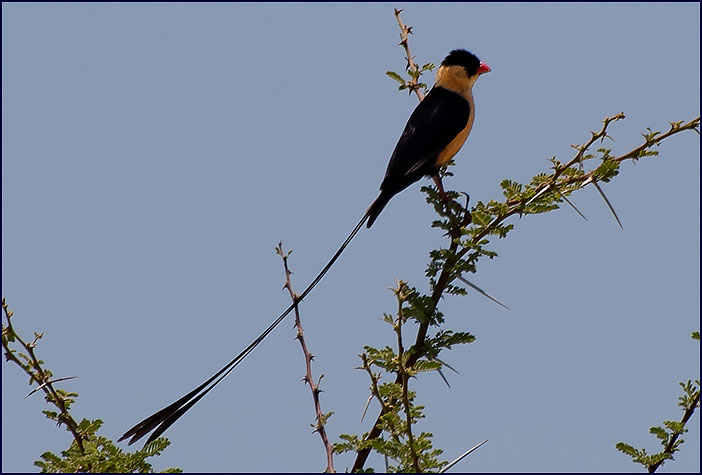
Shaft-tailed whydah |
More gemsboks walked the
plains; they were beautiful and fascinating, and in the clear
morning light they looked like something from a fairy tale. Their
horns really are amazing, incredibly long and lethal-looking. I
can’t imagine carrying the weight of them around all day; I
guess that is why they have such strong muscular necks. Gee told
us that the females have longer horns, but the males’ are
thicker. We asked him why we didn’t see any baby gemsboks; he
said that the mothers with young babies would be hiding in areas
of bushes and trees.
I had been hoping we would get the
chance to see gemsboks in the CKGR; I had already gotten way more
than I could have wished for.
Gee spotted a Red
Hartebeest in the distance, slowly walking across the plain. He
said they are among his favorite Kalahari animals, and quite rare
to see. Indeed, we could see just this one; that seemed unusual
for antelopes, as we usually see them in herds or groups.
A bit smaller than the gemsboks,
he was still a fairly large antelope, and very similar to the
tsessebes in shape. He was a dark reddish-brown color over his
back and neck, lighter brown on his flanks, with black markings on
his legs and face. But the most notable thing about him was his
horns; they were crooked and incredibly thick.
|

Red Hartebeest
|
A small group of gemsboks
walked behind the hartebeest; Gee said they follow him to use him
as bait in case of predators. His path brought him on a tangent
closer to the road, so we were able to get a good look at him. I
thought he seemed lonely.
Gee pointed out a tiny
bird called a Desert Cisticola. Now our bird list was up to four
types of cisticolas; Rattling, Chirping, Zitting and Desert. And
that’s not counting the leaf
cisticolas we often saw, when we thought we had sighted a new
bird but it turned out to be a leaf. These are cousins to the branch
whydahs.
The
sky was a clear brilliant blue overhead as we came to Deception
Pan. This is a wide flat barren expanse with very dark soil and no
vegetation except a little short grass; it must have once been a
large lake. Gee said it is named Deception Pan because the
shimmering heat waves and mirages make it look like water. He said
that there is sometimes water in it after heavy rains, but in
winter it is dry. We could see some huge ruts over 18 inches deep
where a vehicle had been stuck when it was wet – those poor
shmucks must not have been very careful.
On the far side of the
pan a flock of 15 ostriches mingled with a herd of gemsboks. A
couple of giraffes strode by. We watch a pair of black-backed
jackals picking their way across the pan. As we drove forward to
leave, the land cruiser suddenly started sinking. We almost got
stuck; Gee’s skillful driving barely got us out. Looking back,
the ground appeared solid but we had made ruts over a foot and a
half deep across the edge of the pan. Those poor shmucks were now
us! I remembered that in The
Cry of the Kalahari book, the Owens had been told, ‘Whatever
you do, don’t drive across the pans.’
|
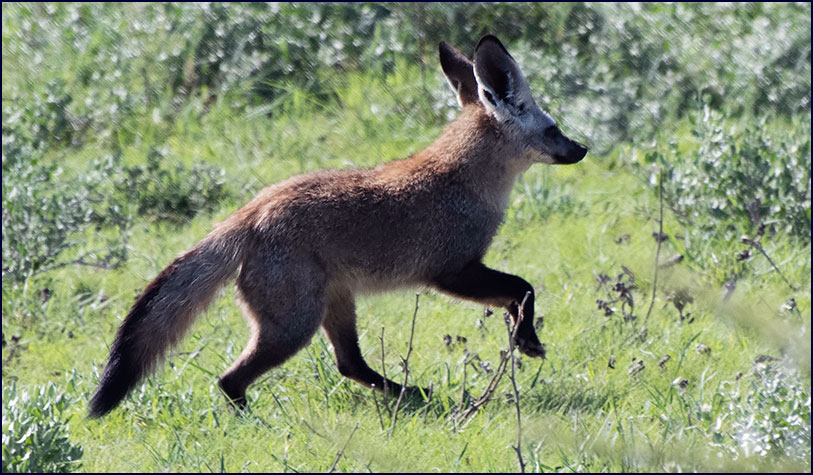
Bat-eared Fox
|
Three Bat-eared foxes saw
us and took off running. They are very shy, so we got a lot of
photos of their round bushy backsides as they ran away from us.
Even from that angle we continued to be impressed by the size of
their ears.
We saw more gemsboks and
springboks grazing in the wide former riverbed. For a moment we
thought we had found one of the elusive baby gemsboks, but it
turned out to be an adult springbok standing next to one of the
oryx, looking like mother and baby.
A pair of jackals trotted
along in the distance, and we spotted several black and white Pied
Crows. I tried to get a photo of a shaft-tailed whydah as he flew
from his tree, but without success.
We came across a small group of
gemsboks with a youngster about a year old; he looked just like a
miniature version of the adults. An old oryx with the points
broken off both of his horns chased a younger bull across the
plain; raising great clouds of dust.
The CKGR is vast and the
roads tend to run straight and long, with few side roads. In
Savuti or Moremi if you saw an animal in the distance there was
usually a network of small tracks and side roads you could use to
get closer; here this was not possible so you must view it from
afar. This made it feel more limited, with less opportunity to
explore.
We often noticed elephant
droppings in the roadway, but we saw no elephants. Gee said there
are some that live in the CKGR, but they are very shy and you
never see them - they stay in the bushes and only come out at
night. And with so few roads in such a huge park, it is easy for
them to stay in areas where vehicles never come. Gee told us he
has never seen one here. Still, the droppings were there, so the
elephants must be around somewhere – we kept a sharp eye out for
them.
We stopped for a tea break around
eleven. When I went behind a bush to answer nature’s call, there
was a sudden flurry of motion and a large owl burst out of the
scrubby trees, being mobbed by a small flock of Fork-tailed
Drongos. I didn’t know those cute little black birds were so
brave.
As we drove on, we saw a
springbok standing alone, guarding his territory like the
wildebeest bulls do. Again, I was struck by the slightly satanic
look of his hircine head and horns. A tiny steenbok stared at us,
all alert eyes and huge ears, and then dashed away out of sight.
His mate must have been nearby; they always live in pairs. Gee
said they bury their poop to avoid detection. We saw three more
hartebeests in the far distance.
|

Greater Kestrel
|
I looked up at the cobalt
blue sky. A tiny round
white cloud was visible, the first we had seen all day. We
gathered it is clear and sunny here most of the time. Before long
another small cloud appeared, and then another; soon they were
dotting the sky. They would change as we watched, forming or
disappearing into the wild blue.
We passed a juvenile dark chanting
goshawk. A Greater Kestrel sat in tree. We watched a Northern
Black Korhaan in flight; these biggish birds are quite attractive
on the ground, but look somewhat awkward when they fly.
At last we found the baby
gemsboks, the first really young ones we had seen. It appeared
there were two young babies with one mom; we weren’t sure if
they were twins, or if the other mother was hiding. They were
small, cute and caramel colored; they looked more like Jersey
calves than gemsboks.
We drove back past the
former campsite of Mark and Delia Owens. A grove of trees stood
like an island amid the wide flat plain that had once been an
ancient river. A herd of gemsbok grazed in front of it. In their
book the Owens’ often mentioned a lion or hyena walking up this
riverbed; it looked very different from what I had envisioned.
There was a carpet of yellow
flowers strewn across the plain, and a herd of springboks grazing.
A couple of the youngsters wrestled, heads down and horns locked.
A lone gemsbok galloped across the plain, kicking up puffs of dust
behind him. The fluffy white clouds amidst the deep blue of the
sky were larger now.
Returning to camp, there
was a beautiful Crimson-breasted Shrike sitting on a small broken
tree, his red, black and white plumage adding brilliance to the
scene. This was another new bird; Sally told us the count was now
up to 218 for the trip, so we had already surpassed her goal of
200. KK, always the well-adorned clown, greeted us wearing a
headdress he had made from a palm frond.
We had lunch, then rested a bit
and organized our kit. The guys had filled our bucket shower, but I both decided to save showering for later.
We set out again at 3.30.
We encountered more ostriches right away, a group of four of them.
We watched with amusement as they pranced about, fluffing their
tail and waving their wing feathers like starlets in a burlesque
show. They were delightfully ridiculous.
We stopped to watch a
kori bustard that was walking right beside the road; he was bigger
than a turkey, and beautiful. He kept turning his head and looking
at us warily, but made no move to run away. Then deciding we might
be a threat after all, he suddenly crouched down on the ground in
an effort to make himself invisible. This strategy might have
worked if the grass was taller and browner, but against the green
well-cropped turf he stood out vividly.
The brilliant blue sky
was now dotted with fluffy white and grey clouds; we watched their
shadows move across the plain. The humidity was low and the air
felt cooler. A jackal was curled up sleeping in the sun.
Three juvenile yellow-billed kites
sat in a tree, their feathers all fluffed out and fuzzy.
We added a couple more birds to Sally’s list; a Kalahari
Scrub Robin and the Ant-eating Chat. The scrub robin was a fairly
plain looking little brown bird, but with a beautiful song; he sat
in a thornbush, tail perkily up and beak open, singing his heart
out.
|

Scrub Robin
|
We stopped to watch a
herd of springboks. We were hoping to see some more pronking, but
it was still a bit too early; Gee said that early morning or just
before sunset is the best time for it. But we did get to see
something just as special; a tiny baby springbok was curled up in
the grass. This was a treat, because the moms keep the really
young babies pretty well hidden. Like the other baby antelopes we
had seen he was a light fawn color, and he did not yet have the
vivid markings of the adults - the better for camouflage, I
suppose. He was not near the road so we couldn't get close, but
even from a distance we could see that he had enormous ears.
Gee told us that the springboks,
like many of the animals in the Kalahari, can survive without
water for years at a time, subsisting on the moisture they get
from plants.
Another hartebeest walked
along in the lovely afternoon light; this was number five. We
could tell it was a different one than we saw earlier because his
horns were longer, more crooked, and not quite as thick. Suddenly
the hartebeest gave us a show, picking up a gallop and bounding
across in front of us, throwing in a few half-bucks for good
measure.
We came across another
baby springbok. This one was a little older, and to our delight he
was lying curled up near the road. He was still quite small, but
he had developed the springbok color and face markings, and we
could see tiny nubs of horns on his forehead. He was exquisitely
beautiful.
We stopped to watch two
young gemsboks mock-fighting in the road. They stood head to head,
lowering their necks and intertwining their long horns. They
pushed and shoved for quite a while, every so often taking a break
to look up and make sure we were still watching.
Suddenly a yearling
gemsbok sailed past and crossed the road in front of us; he seemed
to be floating. He was doing the most amazing extended trot.
Lifting his legs up high in a slow rhythm as if he were performing
a piaffe, his gait had magnificent suspension, and he finished
each magical stride by extending his forelegs out in front of him
flamboyantly. I
felt he should have been winged - and really, he nearly was.
Gee was as amazed as the rest of
us; he said he had never seen anything like that. A dressage
gemsbok! Gee said they
can jump two meters, as well.
|
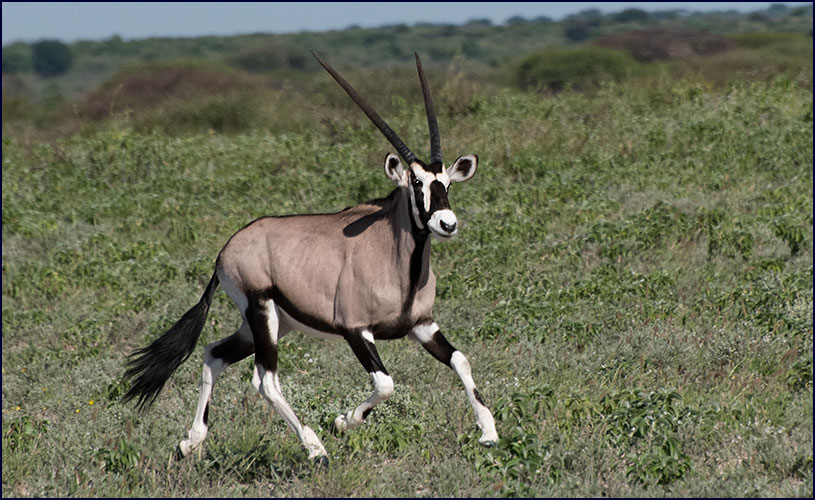
The Dressage Gemsbok |
We noticed a strange
zig-zag mark in the sand, sweeping back and forth across the road.
Gee told us it was where an elephant had walked along swinging his
trunk, the tip of it dragging in the sand. We got a glimpse of
honey badger number eight.
Gee suddenly stopped the
vehicle; he had seen some ears sticking up through the bushes off
to the right. Out came a bat-eared fox; this was the best look we
had gotten of one, and in good light. The size of their ears is
unbelievable. I just had time enough to get a couple of photos
before he turned and ran off. Another good spot by Gee! Nearby we
saw another pair of foxes, hidden in the grass taking a nap.
Two male gemsboks were in
the road fighting. This pair seemed more serious in their intent;
they were down on their knees shoving and bashing into each other,
trying to determine which one was boss. Meanwhile, a wise old bull
with scars on his sides and a knowing look in his eye watched on
serenely.
A lone wildebeest bull
hung out with a herd of gemsboks, guarding his territory for his
ladies, who were off elsewhere. We saw an oryx with one straight
horn, and the other curved down over his back in an S-shape; Gee
said this must have been caused by an injury when he was young. A
bit further on we saw a red hartebeest with especially thick
horns; it may have been the same one we had seen in the morning.
We noticed a very odd
looking springbok. From the middle of his back to the bottom of
his tail, a thick swatch of white bushy hair was standing straight
up. We learned that they display this weird mane-like hair on
their hindquarters when nervous or excited.
A striking black-backed jackal
trotted down the road in front of us, and then moved off through
the tall grass; we stopped and watched him hunt. We noticed a bush
completely encased in dense spider web; Gee said it was a
Community Spider nest. To Paula’s delight we found another
leopard tortoise.
The
sun was getting low as we headed back toward camp. All of the
clouds had disappeared, leaving the sky a clear deepening blue. We
drove back past the springbok herd. There was a doe with a very
young baby near the road. The fawn reminded me of a newborn foal,
all long legs and tiny body. He seemed to be fascinated by our
vehicle, and started walking up the road toward us. When he got
quite close, he turned and scampered off.
Then
the springboks started pronking again! One would start to run, and
then suddenly he would do a series of leaps, rising six feet off
the ground with his back humped up, and his legs and head hanging
straight down. It was amazing to watch, but almost impossible to
photograph – if only they would give me a few seconds warning
when they were going to pronk so I could be ready to focus. They
leap up in such a weird pose that even when you do manage to get a
shot, it’s hard to tell they are high off the ground - it just
looks like they are standing funny.
As the sun lowered toward
the horizon, the jackals were out hunting in force. We watched
them trotting across the plain or hunting in the grass, leaping up
and pouncing on some small prey. The slanting rays from the
setting sun edged each leaf and blade of grass in golden light,
turning the veld into a magical dreamscape.
Back in camp, I took the
shower I had skipped at lunch; the water was still pretty warm
from sun. We had drinks around the fire and watched the full
orange moon rising over the land cruiser.
We heard birds and jackals in the
night, and lions calling in the wee hours of the morning. The
light of the moon painted the bushveld in shimmering silver.
February 20
The sky was crystal clear as we
set out. Gee headed in the direction from which we had heard the
lions roaring in the night. Springboks were grazing in the rosy
pre-dawn light. A scrub hare crouched by the road, hoping to avoid
notice. As the fiery rising sun peeked up through the trees and
turned the sky scarlet, the full moon hung low over the western
horizon. The morning was filled with anticipation. I wonder what will happen next?
The sun was just coming
up when Gee found the lions. Two
regal males were lying quietly in the grass, their heads raised,
looking around in savage
splendor. As the sun topped the horizon, golden light fell
across the huge cats. Their manes were full and thick; the upper
portion gleamed gold and caramel in the sunlight, and underneath
they were black.
The nearer lion lifted
his head and shook his magnificent mane. There were no water
droplets flying off him, no stormy backgrounds nor god’s rays
nor rainbows, but nonetheless I knew that this
was the shot I had been looking for. Then the lion turned and made
eye contact with me for several fleeting moments. I felt he could
see into my soul.
Gee had briefly taken a
little track to get closer to the lions, then we returned to the
main road so as not to disturb them. There was one other vehicle
in the area, a self-driving German couple; they approached us
later and were very rude to Gee – I guess there are jerks
everywhere.
We watched the springboks and
gemsboks in the morning sun. We watched another baby gemsbok put
in an appearance, and more springbok calves. Getting to see all the baby antelopes was one of
the best things about visiting this time of year.
A group of five juvenile
but full-sized ostriches, accompanied by an adult male, were
preening and prancing around. They looked very comical. They
chased each other in a circle, and then three of them took off
running - they are incredibly fast. We had seen an amazing number
of ostriches here in the Kalahari; Gee said they like the wide
open space where predators can’t hide, and they are able to live
without drinking water for months on end.
We stopped at a big
puddle in the road and spent some time watching the birds that
came there to drink. We saw Great Sparrows, and a pretty little
purplish bird called the Violet-eared Waxbill. A whole flock of
red-billed quelias flew busily from bush to bush, and a Laughing
Dove came down to drink. I particularly liked the Namaqua doves;
they are smaller than others, with black faces and throats. A
rufous-naped lark was singing beautifully, and Gee pointed out a
Yellow Canary, which he pronounced Can-a-ry.
|
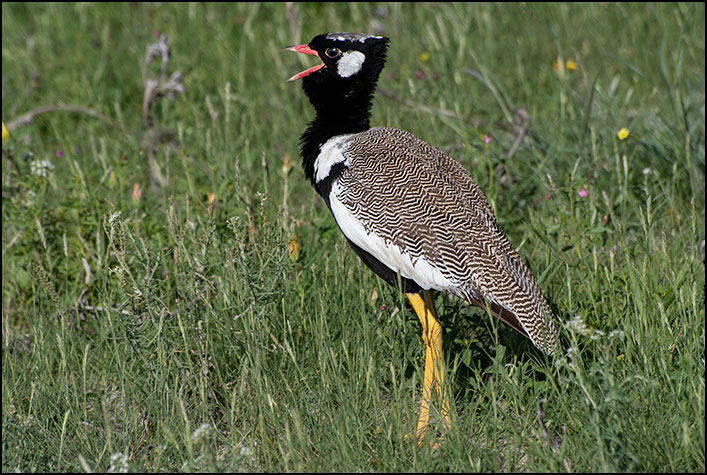
Northern Black Korhaan |
We got a good close look
at a northern black korhaan; they are striking birds with mottled
grey and white feathers on their backs, and black necks and
chests. They are quite noisy; this one opened his mouth wide and
squawked at us. They make loud frantic calls when they fly.
We admired a Greater Blue-eared
Starling in a tree, his dark blue plumage brilliant in the
sunlight. We were serenaded by a Fawn-colored Lark. A family of
adorable ground squirrels were busy foraging; we watched as they
scurried back and forth furtively, periodically standing up tall
on their hind legs to scan for predators.
|

Fawn-colored Lark
|
We drove over a sand
ridge and traveled a long way through a forest of denser brush
and scrubby trees. The terrain was slightly rolling. We were
heading for Passarge Valley. We saw many birds but few animals.
A Lesser Grey Shrike perched on a
twig; he had a black mask like the lone ranger. We got a close
look at an aptly named shaft-tailed whydah; his tail consisted of
three gloriously long shafts that ended in narrow feathers. A pair
of red-headed finches watched us from a tree, and we saw a
European Bee-eater, larger than his ‘Little’ cousins, with
lovely brilliant colors.
A pale-chanting goshawk flew overhead.
I had not realized there
was so much wooded area in the Kalahari, but when we came down off
the sand ridge to the Passarge Valley area it was wide open again.
We drove down a slight hill and Leopard Pan was stretched before
us. The ancient riverbed valley was a wide flat grassy expanse; it
must be a mile across. Gee said the whole system of rivers
connects in a big loop.
We drove on through Passarge
Valley. This looked like a place for cheetahs; they love the wide
open plains where they can see a long way, and use their
incredible speed to hunt. Gee explained that cheetahs only need to
get within 50 meters of prey before starting a chase, as opposed
to lions who need to get within 5 meters before pouncing.
We carried on around the edge of
the pan searching for their lean feline shapes. We did not find
cheetahs, but truly it didn't matter. Gee says that some visitors
are only interested in the big predators, and in checking them off
their list. But for our group, going on safari is about seeing everything,
all the small things as well as the large. It is about the search
to find the animals, and then spending time with them and watching
them interact.
Paula spotted yet another
honey badger – number 9. We noticed it’s back seemed brown;
Gee said the young ones are like that. We also found leopard
tortoise number seven; it had a beautiful patterned shell, more
yellow than the others we had seen.
|
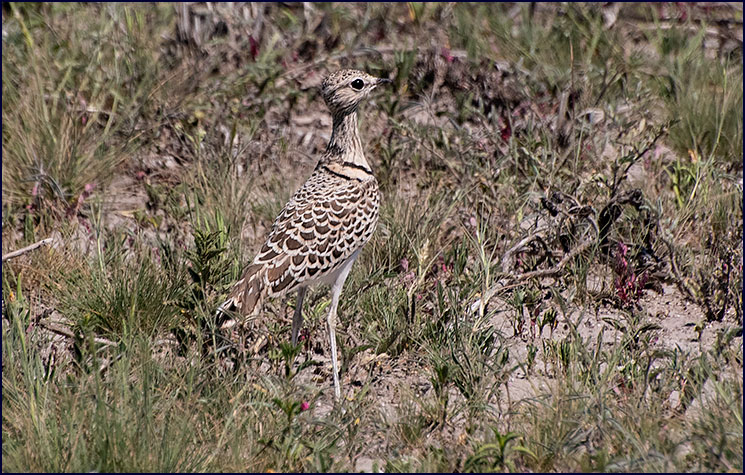
A Double-banded Courser, perfectly camouflaged.
|
A double-banded courser
was camouflaged in a patch of dry grass; he was a beautiful
long-legged bird with brown feathers edged in white, and huge
eyes. A dainty steenbok posed for us. He had sharp little horns,
and the colors inside of his large ears reminded me of seashells.
|
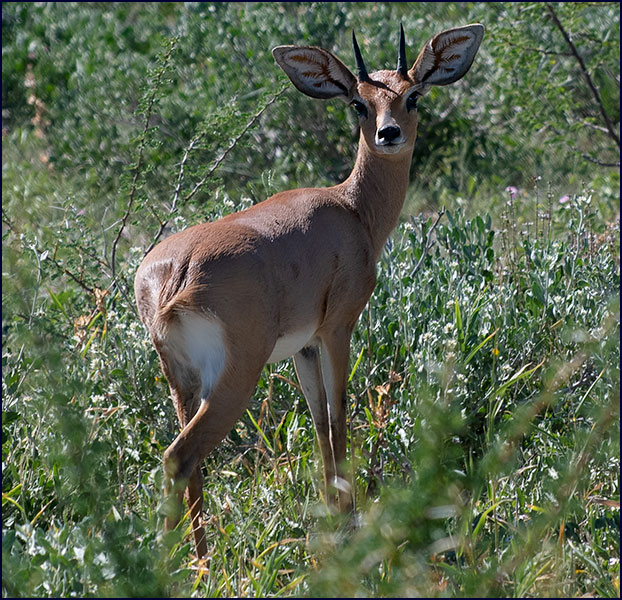
Steenbok
|
After we stopped for tea,
Gee asked me if I wanted to drive again. I was not sure if he
really wanted a break or was just being nice – but I jumped at
the chance! I was a little better at it this time, smoother with
changing the gears. But I wasn't sure how fast to go - it felt
like I was going too slow, but every time I tried to speed up I
would invariably hit a bumpy patch in the road and jar
everyone’s teeth out. But I was having fun!
At a certain spot Gee asked me to
stop and he got out of the vehicle; he picked up cheetah skull to
show us. He told us about how a leopard had killed this cheetah;
on a previous trip he had seen the dead cheetah and from the
tracks had deduced what had happened.
As I was driving along two
ostriches suddenly burst out of the bushes and crossed the road at
a run right in front of me - I had to brake hard to avoid hitting
them. After an hour and a half Gee took over driving again, so
that we would make it to lunch on time. I guess I was going to
slow!
We continued to see many
birds. The korhaans were everywhere; the males would fly up in
awkward flight patterns with raucous noisy displays. An ant-eating
chat was sticking his tail straight up in the air in an effort to
attract a mate. A pale chanting goshawk looked down at us from a
treetop with a fierce stern expression. We saw a couple more new
ones; a diminutive African Pippet, and a Cape Crow, his black
wings so shiny they looked white in the sunlight.
Gee turned on a tiny track up a
hill to a vacant campsite, and at the top were BD and KK with
lunch. The serving table was set up under a large tree, with our
camp chairs waiting for us in a semi-circle. The guys had made a
sculpture of sorts out of some branches, seed pods and an old
bird’s nest. We had an excellent lunch as usual, and a one hour
rest stop. A white-browed sparrow weaver was flitting back and
forth on the tree limbs above us. I expect he was hoping for a
handout, but Gee had impressed upon us the importance of not
feeding the wildlife.
|
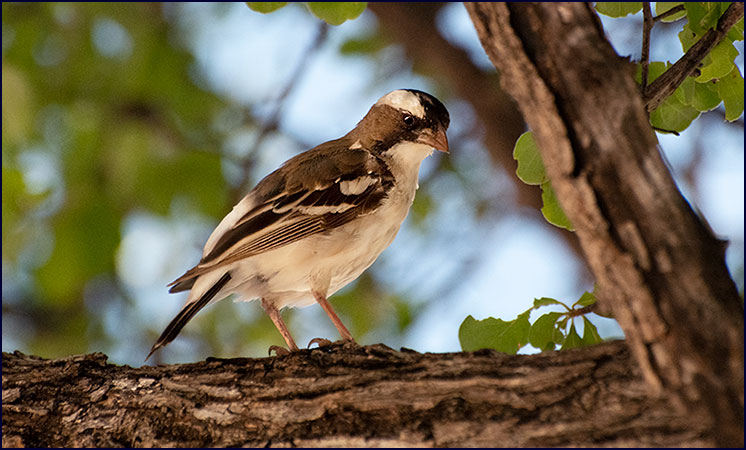
This little Sparrow Weaver wanted to share our lunch.
|
After lunch we went to
the Sunday Pan waterhole, which had a borehole with a solar pump.
We watched the gemsboks and springboks came down to drink. The
springboks daintily sipped from the edge of the waterhole, while
the gemsboks waded in like they owned the place.
Shaft-tailed whydahs were flying
back and forth; I was trying to get photos of them in flight, but
they are small and quick so it was really difficult to focus on
them. Gee got some good shots, but mine were all blurry. Gee
pointed out some fingergrass, and said it is why animals come to
Kalahari.
It was a long drive back
to Deception Valley, and we took a different route home.
Occasionally I found myself nodding a bit and almost dozing off;
it is amazing how you can do that in the bouncing truck. The road
went straight over a number of sand ridges; we could see it ahead
of us topping each hill, cutting through the trees before
descending into the next valley.
Paula read the maps and did some
calculating, and became concerned that Gee might be going the
wrong way; we knew he had not guided a lot in the Kalahari, and
could be forgiven for not knowing his way around every road. But
then we came down the last ridge and Deception Valley stretched in
front of us; we should not have doubted Gee’s navigating skills
for an instant.
Suddenly a gemsbok dashed
across the road in front of us, alarmed by our vehicle. He stopped
and turned to look at us angrily, and then he savaged a small
bush. Mad with us, he took it out on the shrubbery, repeatedly
attacking the bush, kneeling and tearing it to pieces with his
sabre-like horns. Once he had flattened it to his satisfaction he
looked at us smugly, and having clearly shown us who was boss, he
dashed off into the trees.
|
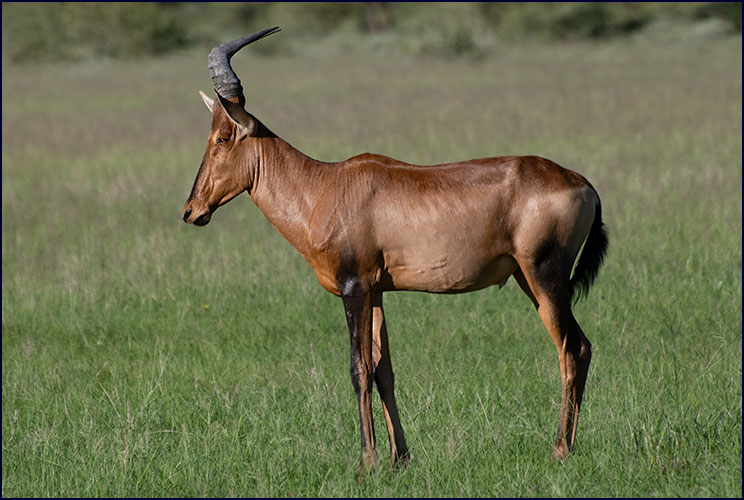
Red Hartebeest
|
Back in Deception Valley,
we saw all of the usual antelopes: springboks, gemsboks, and our
friend the hartebeest. We watched as a herd of gemsboks approached
a small waterhole, but then they seemed indifferent about
drinking. They would come to the water and lower their heads as if
they were going to drink, but then decide not to bother. They can
survive on the moisture they get from grazing without drinking
water.
|
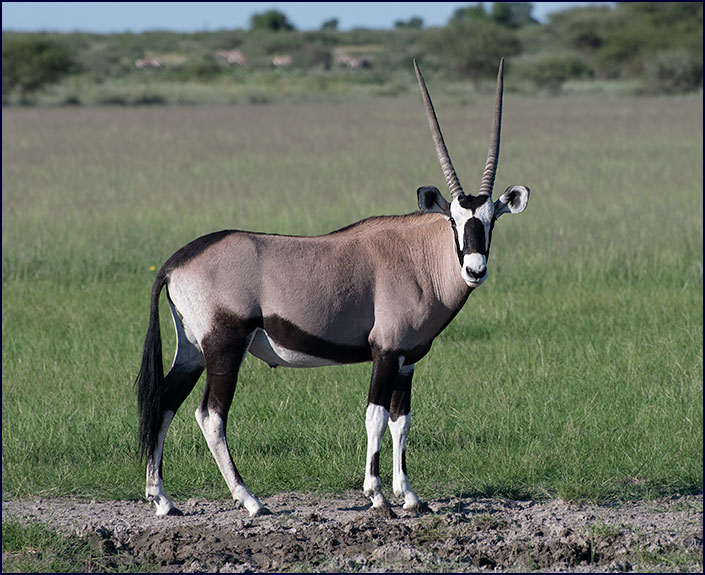
A young Gemsbok, not bothering to drink.
|
We scanned the plain as
we drove slowly along. Whenever we saw a tawny flash in the
distance that we thought might be a cheetah or a lion, it usually
turned out to be a kori bustard – they were everywhere. We saw
another male in full display mode, tail up and neck puffed out
like a huge muff.
Gee spotted a leopard in the
distance, beside a large bushy tree. Most of us didn’t really
see it; just a glimpse of motion as it vanished into the brush.
The count for leopards and lions was now tied at 13 each. We drove
around the block hoping to catch another glimpse of either Gee’s
leopard or the lions from the morning. We found two more honey
badgers, and watched them as they snuffled around side by side
looking for food. The honey badger count was up to ten now. Crazy.
Close to camp there was a
twisted fallen log under a spinney of trees; at a glance the
silhouette of it looked like a standing lion. . We called it the
Lion Log, because every time we drove past it there was an instant
where one of us thought it was a real lion.
The Kalahari has less
variety of animals than Savuti or the Okavango, but it does have
some great ones that are not seen in those places, such as the
gemsboks, springboks, hartebeest and bat-eared foxes, as well as
dozens of different birds. We also saw ostriches, jackals and kori
bustards in much greater numbers.
There were very few other people
or vehicles in the CKGR and the distances were vast, but still
somehow it felt more regulated, and the lack of small side roads
made it hard to explore. Also, we noticed our rude German friends
seemed to be following us.
We drove straight towards
the setting sun. The sky was crystal clear, like Savuti in winter.
Brilliant colors painted the horizon, with a palette of orange,
rose, mauve and blue. Back in camp we loved the artistic touches;
our napkins were in our wine glasses, folded into swans.
The waning moon did not come up
until later so we could see the stars bright overhead; this was
the first night they had not been obscured by either clouds or a
near-full moon. The one thing I had really missed from the winter
trips was the intensity of the stars. But now we could see the
Southern Cross and Scorpius overhead, glittering like diamonds
strewn across the sky.
The moon rose during dinner, fat
and orange, one day past full. We could hear jackals yipping in
the night, and the squawky loud voices of the francolins. Looking
out in the early morning hours, Orion and Canis Major were radiant
overhead, and Venus and Jupiter shone like bright beacons.
|